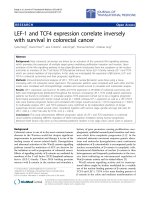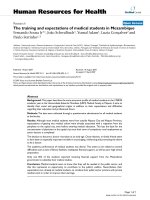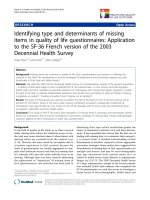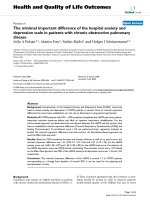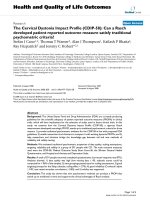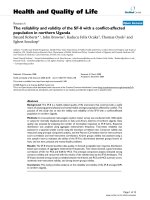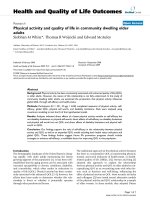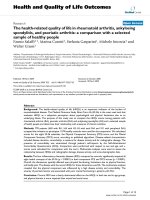báo cáo hóa học:"The cost and impact of male circumcision on HIV/AIDS in Botswana" potx
Bạn đang xem bản rút gọn của tài liệu. Xem và tải ngay bản đầy đủ của tài liệu tại đây (636.44 KB, 8 trang )
BioMed Central
Page 1 of 8
(page number not for citation purposes)
Journal of the International AIDS
Society
Open Access
Research
The cost and impact of male circumcision on HIV/AIDS in Botswana
Lori A Bollinger*
1
, John Stover
1
, Godfrey Musuka
2
, Boga Fidzani
2,3
,
Themba Moeti
2
and Lesego Busang
2
Address:
1
Futures Institute, Glastonbury, Connecticut, USA,
2
African Comprehensive HIV/AIDS Partnership, Gaborone, Botswana and
3
National
AIDS Coordinating Agency, Gaborone, Botswana
Email: Lori A Bollinger* - ; John Stover - ; Godfrey Musuka - ;
Boga Fidzani - ; Themba Moeti - ; Lesego Busang -
* Corresponding author
Abstract
The HIV/AIDS epidemic continues to be a major issue facing Botswana, with overall adult HIV
prevalence estimated to be 25.7 percent in 2007. This paper estimates the cost and impact of the
draft Ministry of Health male circumcision strategy using the UNAIDS/WHO Decision-Makers'
Programme Planning Tool (DMPPT). Demographic data and HIV prevalence estimates from the
recent National AIDS Coordinating Agency estimations are used as input to the DMPPT to
estimate the impact of scaling-up male circumcision on the HIV/AIDS epidemic. These data are
supplemented by programmatic information from the draft Botswana National Strategy for Safe
Male Circumcision, including information on unit cost and program goals. Alternative scenarios
were developed in consultation with stakeholders. Results suggest that scaling-up adult and
neonatal circumcision to reach 80% coverage by 2012 would result in averting almost 70,000 new
HIV infections through 2025, at a total net cost of US$47 million across that same period. This
results in an average cost per HIV infection averted of US$689. Changing the target year to 2015
and the scale-up pattern to a linear pattern results in a more evenly-distributed number of MCs
required, and averts approximately 60,000 new HIV infections through 2025. Other scenarios
explored include the effect of risk compensation and the impact of increasing coverage of general
prevention interventions. Scaling-up safe male circumcision has the potential to reduce the impact
of HIV/AIDS in Botswana significantly; program design elements such as feasible patterns of scale-
up and inclusion of counselling are important in evaluating the overall success of the program.
Background
The HIV/AIDS epidemic continues to be a major issue fac-
ing Botswana, with overall adult HIV prevalence esti-
mated to be 25.7% in 2007 [1]. As an add-on strategy to
augment its efforts to reduce HIV prevalence, the Ministry
of Health has drafted a male circumcision strategy [2]. In
addition, there has been a significant increase in the pro-
vision of antiretroviral therapy (ART) in Botswana, which
also has an impact on HIV prevalence levels.
Male circumcision has been shown to reduce HIV trans-
mission from females to males in various settings. Three
randomized controlled trials, in South Africa, Uganda and
Kenya, showed that HIV transmission from females to
males was reduced by up to 60% when male circumcision
was undertaken [3-5]. In countries where the prevalence
of male circumcision is low, as in Botswana, there is great
potential to reduce HIV prevalence rates through imple-
menting interventions offering safe male circumcision [6].
Published: 27 May 2009
Journal of the International AIDS Society 2009, 12:7 doi:10.1186/1758-2652-12-7
Received: 20 November 2008
Accepted: 27 May 2009
This article is available from: />© 2009 Bollinger et al; licensee BioMed Central Ltd.
This is an Open Access article distributed under the terms of the Creative Commons Attribution License ( />),
which permits unrestricted use, distribution, and reproduction in any medium, provided the original work is properly cited.
Journal of the International AIDS Society 2009, 12:7 />Page 2 of 8
(page number not for citation purposes)
Several modelling studies have been published recently
for various countries in sub-Saharan Africa that examine
the impact of scaling up male circumcision on HIV inci-
dence and prevalence levels, including Kenya [7], Uganda
[8], South Africa [9,10], and southern Africa in general
[11,12]. The reduction in HIV incidence rates after 10
years in these studies varies from 10% to 55%, while
decreases in HIV prevalence rates after 10 years varies
from 17% to 50%.
Because of this high level of effectiveness, Botswana is
exploring the future costs and impact of implementing
safe male circumcision. The purpose of this research is to
estimate the overall cost and impact of a scaled-up pro-
gramme of safe male circumcision in Botswana, including
the impact of alternative scenarios.
Methods
Demographic estimates and projections of impact of HIV
prevalence use data from the recent estimates and simula-
tions undertaken by the Botswana National AIDS Coordi-
nating Agency [13] as input to the male circumcision
Decision-Makers' Programme Planning Tool (DMPPT)
[14] of the Joint United Nations Programme on HIV/AIDS
(UNAIDS) and World Health Organization (WHO). The
epidemiologic research utilized antenatal clinic sentinel
surveillance data and the Botswana AIDS Impact Survey of
2004 to estimate HIV prevalence in Botswana from 1980
to 2007 using the UNAIDS Epidemic Projection Package
[15].
The national-level prevalence projection was then com-
bined with age-specific and sex-specific HIV prevalence
data from the 2004 impact survey in the AIM module of
Spectrum [16] to calculate the number of people infected
with HIV, including new infant infections based on the
programmes in Botswana that currently provide antiretro-
viral prophylaxis and replacement feeding, as well as
other relevant indicators.
These estimates are then used in the UNAIDS/WHO
DMPPT, which calculates the cost of male circumcision
services by delivery mode, based on clinical guidelines
and local costs for both direct and shared facility and staff
costs. The tool then estimates the impact of the epidemic
using a transmission model that calculates new infections
by age and sex as a function of the current force of infec-
tion, coverage levels, and speed of scale up.
This model is intended to support policy development
and planning for scaling up services to provide male cir-
cumcision. It allows analysts and decision makers to
understand the costs and impacts of policy options, and is
a part of a larger tool kit developed by UNAIDS/WHO that
provides guidelines on comprehensive approaches to
male circumcision, including types of surgical procedures
and key policy and cultural issues.
The data from the National AIDS Coordinating Agency
estimates are supplemented by programmatic informa-
tion from the draft national male circumcision strategy,
including information on unit cost and programme goals.
In addition, a stakeholders' workshop was held in Bot-
swana's capital city, Gaborone, on 2 October 2008, during
which data assumptions were reviewed and scenarios
developed.
The male circumcision (MC) model has two components:
costing and impact. The initial unit cost of an uncompli-
cated adult male circumcision of US$48 in the public sec-
tor was provided in the national strategy, so the costing
component of the model was not applied in Botswana.
Three other unit costs were developed and agreed upon
during the workshop: a neonatal circumcision unit cost of
$38 (assumed to be 20% lower than the adult cost, due to
lower complication rates and lower costs for commodi-
ties), and private provider unit costs for both adult and
neonatal circumcisions of $60 and $48 (assumed to be
25% higher than the relevant public sector costs). In addi-
tion, user fees of $1 for public sector and $25 for private
providers were assumed.
The impact component of the model addresses the follow-
ing key policy areas:
• priority populations: a choice of all male adults,
young adults, adolescents, newborns, and men at
higher risk of HIV exposure
• target coverage levels and rates of scale up
• service delivery modes: hospital, clinic, mobile van;
public, private, non-governmental organization; and
"other"
• impact of other prevention activities and risk com-
pensation effects.
A wide variety of inputs is required, including:
• demographic: size of various population groups
• epidemiological: HIV prevalence rates for overall
population and specific groups, underlying transmis-
sion factors (based on scientific evidence), effective-
ness of male circumcision in reducing transmission
• sexual behaviour: sexual mixing matrix
Journal of the International AIDS Society 2009, 12:7 />Page 3 of 8
(page number not for citation purposes)
• programmatic: target populations, rate and timing of
scale up, service delivery mode
• economic: unit cost (described above), discounted
lifetime cost of ART.
A complete listing of the data and assumptions used in the
model will be provided upon request. Much of the data
are derived from either the Botswana AIDS Impact Survey
II or the national agency estimates.
The programmatic decisions, such as rate and timing of
scale up, were agreed upon during the stakeholders' work-
shop. Some of the parameters were varied in order to per-
form sensitivity analyses; the specific scenarios presented
here were discussed during the stakeholders' workshop.
Results and discussion
Scenario 1: national strategy scenario
Scenario 1 presents the impact of increasing the preva-
lence of male circumcision to 80% of HIV-negative adult
males and neonates by 2012, based on the objectives
expressed in the national strategy. It is assumed that the
scaling up begins in 2009 and follows an S-shaped pattern
to allow for training of physicians and other infrastructure
developments. Although the scaling up is completed by
2012, results are presented through 2025 in order to
measure the long-term impact of increasing the preva-
lence of male circumcision.
Figure 1 presents the number of male circumcisions per-
formed for the "Base" scenario, where the current preva-
lence rate of MC is held constant at the initial level of
10.2% throughout the time period, and the "MC" sce-
nario, where circumcision is scaled up according to the
pattern described for Scenario 1.
The number of circumcisions performed in the "Base" sce-
nario reflects the constant MC prevalence rate specified
over the time period remaining relatively constant at
around 4700 per year.
When safe male circumcision is scaled up to reach a prev-
alence rate of 80% by 2012, there is a rapid increase in the
number of circumcisions performed for the first four years
of the scenario, as the programme plays catch up with the
stock of uncircumcised men, reaching a peak of over
140,000. By 2013, the number begins to drop, and the
final number required levels off to reach a rate of about
43,000 circumcisions per year for the duration of the time
period.
There is a strong impact of scaling up safe male circumci-
sion on the number of new adult infections (see Figure 2).
While the number of new infections declines in the "Base"
scenario from about 18,000 in 2007 to 13,400 by 2025,
the number of new infections in the MC scenario declines
even further, to reach about 7600 by 2025. Note that the
decline starts when the programme begins to scale up, but
then continues throughout the time period, illustrating
why it is important to show the impact of the MC for a
longer time period.
Overall, between 2008 and 2015, about 18,000 cumula-
tive HIV infections, or 14% of total new HIV infections,
are averted. Over the next 10-year time period (2016–
2025), the number of cumulative new HIV infections
averted reaches more than 51,000, or 38% of all new
infections.
Although the primary impact of increasing the prevalence
of male circumcision is to reduce the number of new HIV
infections in men, the number of new HIV infections in
Number of male circumcisions performed by scenarioFigure 1
Number of male circumcisions performed by sce-
nario.
New adult HIV infections by scenarioFigure 2
New adult HIV infections by scenario.
Journal of the International AIDS Society 2009, 12:7 />Page 4 of 8
(page number not for citation purposes)
women is also reduced via secondary impacts. Figure 3
shows the cumulative impact from 2008–2025 of increas-
ing male circumcision on both males and females, split
into the two different age groups (15 to 29, and 30 to 49).
The cumulative number of new HIV infections for men
drops by over 18,000 for those aged 15 to 29 and by about
26,000 for those aged 30 to 49. The cumulative number of
new HIV infections for women drops by more than
17,000 for those aged 15 to 29 and by about 7000 for
those aged 30 to 49.
The number of male circumcisions that are required in
order to avert one HIV infection is calculated by dividing
the increase in the number of male circumcisions per-
formed by the number of HIV infections averted over the
relevant time period:
where X = number of male circumcisions
Y = number of HIV infections, and
t = 2008–2015 and 2016–2025.
Between 2008 and 2015, 27.3 male circumcisions are
required in order to avert one HIV infection. Because of
the increasing impact of circumcision over time, however,
this statistic decreases when it is calculated for the time
period 2016–2025, reaching a low value of 7.3 circumci-
sions that need to be performed in order for an infection
to be averted.
Note that this is an upper bound for this statistic as the
impact of including male circumcision (especially neona-
tal MC) will extend beyond the current time horizon of
the model. These statistics can be compared to similar sta-
tistics from other studies, including a figure of six for
Lesotho, four for Swaziland, and eight for Zambia [17].
The final piece to the puzzle is the cost of the programme,
which needs to be evaluated relative to its effectiveness.
Note that, in addition to the unit costs of male circumci-
sion discussed here, the national strategy calls for spend-
ing 14.4 million Botswana pula (P), which equals about
US$2.3 million, over five years to generate demand. Also
note that after discussion, experts agreed that approxi-
mately 80% of male circumcisions would take place in the
public sector, and approximately 20% would be per-
formed by private providers.
The total net cost of the new male circumcision pro-
gramme reaches a peak of $6.5 million, and then returns
to a stable level of about $1.7 million per year required to
maintain a circumcision prevalence rate of 80%, where
net cost is defined as the total cost of all male circumci-
sions performed in all service delivery modes, less any
user fees collected. In contrast, in the "Base" scenario, the
current expenditure on male circumcision remains at
about $200,000 for the duration of the timeframe (see
Figure 4).
The total cost by year is displayed in the first two columns
of Table 1, along with the incremental cost in the final col-
umn, and the cumulative total for two time periods in the
last two rows. The cumulative cost for implementing a
scaled-up MC programme through 2015 is $23 million,
New adult HIV infections by scenario by age and sex, 2008–2025Figure 3
New adult HIV infections by scenario by age and sex,
2008–2025.
Total net cost of male circumcision programme in US dollars (net of user fees collected)Figure 4
Total net cost of male circumcision programme in
US dollars (net of user fees collected).
Journal of the International AIDS Society 2009, 12:7 />Page 5 of 8
(page number not for citation purposes)
while the cumulative cost between 2016 and 2025 is
about $17 million, resulting in a total cumulative cost for
scaled-up male circumcision through 2025 of approxi-
mately $40 million.
Combining this result with the number of HIV infections
averted results in a calculation of discounted net cost per
HIV infection averted. Overall, the discounted net cost per
HIV infection averted for the time period 2008–2015 is
$1353. When the discounted net costs and number of
infections averted are evaluated for the entire time period
of the scenario, 2008–2025, the discounted net cost per
HIV infection averted drops to $642.
In addition, net savings per HIV infection averted are cal-
culated as the savings due to future ART costs avoided,
minus the net circumcision costs, where the discounted
lifetime cost of ART is based on a unit cost of P3599 in
2010 and P4135 in 2015 for first-line antiretrovirals
(ARVs) with an additional $133 for second-line ARVs
[18].
In addition, we assume continuation rates on ART of 91%
for the first year and 99% for subsequent years [16]. The
net savings, assuming a discounted lifetime cost of ART of
$11,258, equals $9905 for the time period 2008–2015,
and $10,616 when evaluated across the entire time
period.
Net costs and savings can also be calculated relative to the
number of male circumcisions performed. Net costs rela-
tive to MC performed remains about the same across the
two time periods, while the net savings per circumcision
performed increases substantially once the savings are
evaluated over the entire time period, from $200 to $427.
Finally, a sensitivity analysis can be performed for some of
the key parameters, including: the reduction in female-to-
male transmission, which is assumed initially to be 60%;
the reduction in male-to-female transmission, which is
assumed initially to be 0%; the discount rate, which is
assumed initially to be 3%; and the discounted lifetime
cost of ART, which is assumed initially to be $11,000 for
the purposes of this sensitivity analysis. The results of the
sensitivity analysis are shown in Table 2. Each of the ini-
tial values of the parameters in the sensitivity analysis is
shown in bolded, italicized font.
The results are as expected, and help to confirm the
robustness of the model. If the effectiveness of male cir-
cumcision on the transmission probability is reduced so
that the transmission rate is relatively higher, the number
of HIV infections averted decreases, and the cost per infec-
tion averted increases. If instead the effectiveness of cir-
cumcision is higher, so that the transmission probability
is reduced even further than the initial reduction of 60%,
then the number of infections averted increases, and the
net cost per infection decreases.
If the cost net of user fees of circumcision increases
because of a higher discount rate, then the cost per infec-
tion averted increases. If the discounted lifetime cost of
ART increases (decreases), then the effect is to increase
(decrease) the net savings per HIV infection averted.
Given these results, the stakeholders' workshop recom-
mended exploring further scenarios:
• Scenario 2: What is the impact of changing the target
date of full coverage from 2012 to 2015?
• Scenario 3: What is the impact of reversing behav-
iour change that may occur due to risk compensation
effects?
• Scenario 4: What is the impact of increasing the cov-
erage of other general prevention programmes to 80%
with a resulting decline in risky behaviours of 35%?
Scenario 2: target date of 2015
Because of the huge number of male circumcisions that
would be required in order to reach the specified target of
80% by 2012, an alternative scenario was suggested dur-
ing the workshop where the target date is changed to
Table 1: Net cost of scaled-up male circumcision programme
(net of user fees collected)
Year Base projection MC projection Additional cost
2005 207,345 207,345 0
2006 207,395 207,395 0
2007 207,445 207,445 0
2008 207,495 665,114 457,619
2009 207,545 2,346,725 2,139,180
2010 207,596 6,224,314 6,016,718
2011 207,646 6,706,579 6,498,933
2012 207,696 3,123,637 2,915,941
2013 207,746 2,005,039 1,797,292
2014 207,797 1,842,539 1,634,743
2015 207,847 1,833,937 1,626,090
2016 207,897 1,846,128 1,638,231
2017 207,947 1,860,367 1,652,420
2018 207,998 1,874,046 1,666,048
2019 208,048 1,886,770 1,678,722
2020 208,098 1,898,452 1,690,354
2021 208,149 1,909,053 1,700,904
2022 208,199 1,918,568 1,710,369
2023 208,249 1,927,124 1,718,875
2024 208,300 1,934,720 1,726,420
2025 208,350 1,938,336 1,729,986
2008–2015 1,661,368 24,747,884 23,086,516
2016–2025 2,081,235 18,993,563 16,912,328
Journal of the International AIDS Society 2009, 12:7 />Page 6 of 8
(page number not for citation purposes)
2015, and the scale-up pattern is linear rather than S-
shaped.
These changes result in smoothing out the number of
total male circumcisions required over the time period,
with a peak of around 85,000 circumcisions required in
2015 compared to the peak of almost 150,000 circumci-
sions required in Scenario 1. The impact on the number of
new adult HIV infections of postponing the target year to
2015 can be seen in Figure 5.
Here, the number of new adult HIV infections declines as
well, reaching a level of 7900 by 2025, which is somewhat
higher than the 7673 reached by 2025 in the initial sce-
nario. Postponing the target year to 2015 and changing
the scale-up pattern to linear averts approximately 60,000
new adult HIV infections cumulatively through 2025,
while the initial scenario resulted in approximately
70,000 new adult HIV infections averted through 2025.
Because of the lower number of infections averted, the net
cost per infection averted increases slightly, from $1353 to
$1953 over the time period 2008–2015, and from $642 to
$759 over the time period 2008–2025.
Scenario 3: risk compensation
Another concern that was raised during the workshop was
whether, despite the counselling that would take place,
men circumcised through this intervention and their part-
ners would begin practicing riskier sex due to perceived
risk reduction as a result of circumcision. Although the
biological impact of male circumcision is to reduce HIV
transmission, this impact might be ameliorated if behav-
iour reversals occur.
The model calculates the impact of risky sexual behav-
iours reverting to patterns that existed earlier in the epi-
demic, prior to the roll-out of the MC programme. Note
that this impact is not due to early resumption of sexual
activity, but instead is the result of changing back to pre-
vious sexual behaviours, such as lower condom use and/
or more sexual partners.
The "Base" case in this instance is Scenario 1, the national
strategy scenario; "MC" is the previous scenario; and "RC"
is the result if risk compensation (RC) occurs (in this case,
Table 2: Sensitivity analysis of key parameters (2008–2025)
Parameter values Infections averted Number of circumcisions
per infection averted
Cost net of user fees per
infection averted
Cost savings per
infection averted
Base case 51,518 7.3 $642 $10,616
Effectiveness 30% 25,059 14.7 $1,313 $9,945
60% 51,518 7.3 $642 $10,616
75% 65,218 5.8 $508 $10,750
Reduction in M->F
transmission
0% 51,518 7.3 $642 $10,616
30% 67,444 5.7 $473 $10,785
Discount rate 3% 51,518 7.3 $642 $10,616
5% 51,518 7.3 $691 $10,567
7% 51,518 7.3 $743 $10,515
Lifetime cost of ART $8,000 51,518 7.3 $642 $7,358
$11,000 51,518 7.3 $642 $10,358
$14,000 51,518 7.3 $642 $13,358
Minimum 25,059 5.7 $473 $7,358
Base Case 51,518 7.3 $642 $10,616
Maximum 67,444 14.7 $1,313 $13,358
Number of new adult HIV infections for Scenario 2 – 2015 target yearFigure 5
Number of new adult HIV infections for Scenario 2 –
2015 target year.
Journal of the International AIDS Society 2009, 12:7 />Page 7 of 8
(page number not for citation purposes)
if 50% of circumcised men reverse their behaviour to pre-
vious, riskier sexual behaviour).
If half of newly circumcised men revert to sexual behav-
iours they practiced before being circumcised, the number
of new HIV infections decreases relative to the "Base" case,
but at a lower rate than before, as shown in the "RC" sce-
nario (see Figure 6). Thus it is imperative that appropriate
counselling occurs during the visits prior to and following
the actual male circumcision procedure.
Scenario 4: increasing coverage of general prevention
interventions
The last scenario to be explored is the impact of increasing
the coverage of general prevention interventions from
20% to 80%, along with increasing the male circumcision
prevalence rate. The impact is calculated as a proportional
reduction in the force of infection at full coverage due to
behaviour changes, such as increasing condom use and
decreasing number of partners.
Although the default value of the proportional reduction
is 70%, the consensus at the workshop was that this pro-
portional reduction should be half the default value, or a
35% reduction in the force of infection, in Botswana, due
to country-specific characteristics (see Figure 7).
The initial impact of increasing the coverage of general
prevention interventions can be seen in the "Prevention"
case, where the number of new adult HIV infections
reaches a new value of approximately 10,800 in 2025,
compared to the previous value of 13,400 in 2025 in the
first scenario.
Adding the impact of a scaled-up MC programme to the
scaled-up prevention results in a further decline in the
number of new adult HIV infections – to a level of 6600
in 2025 in the "Prevention+MC" scenario. This is even
lower than the level of 7700 in the scenario "MC only",
which is the result of the initial scenario. Thus the level of
new adult HIV infections is lower once male circumcision
programmes are scaled up, even if other, more general
prevention programmes are scaled up as well.
Conclusion
As part of its long-term planning process, the Botswana
Ministry of Health and the National AIDS Coordinating
Agency requested analyses regarding the cost and impact
of scaling up safe male circumcision. Building on previous
HIV prevalence estimates recently completed in Bot-
swana, the UNAIDS/WHO DMPPT for male circumcision
was applied in Botswana, including participation of vari-
ous stakeholders in a workshop on 2 October 2008 to val-
idate the data inputs and policy assumptions used in the
MC model.
Results from the MC model suggest that scaling up adult
and neonatal circumcision to reach 80% coverage by 2012
would result in averting almost 70,000 new HIV infec-
tions through 2025, at a total net cost of $47 million
across that same period, resulting in an average cost per
HIV infection averted of $642.
Although scaling up coverage to 80% by 2012 using an S-
shaped pattern would have a significant impact on reduc-
ing the number of new HIV infections, it would also
require circumcising a huge number of men; male circum-
cisions required reach almost 150,000 in 2011 before lev-
Number of new adult HIV infections for Scenario 3 – risk compensation effectsFigure 6
Number of new adult HIV infections for Scenario 3 –
risk compensation effects.
Number of new adult HIV infections for Scenario 4 – full pre-vention coverageFigure 7
Number of new adult HIV infections for Scenario 4 –
full prevention coverage.
Publish with BioMed Central and every
scientist can read your work free of charge
"BioMed Central will be the most significant development for
disseminating the results of biomedical research in our lifetime."
Sir Paul Nurse, Cancer Research UK
Your research papers will be:
available free of charge to the entire biomedical community
peer reviewed and published immediately upon acceptance
cited in PubMed and archived on PubMed Central
yours — you keep the copyright
Submit your manuscript here:
/>BioMedcentral
Journal of the International AIDS Society 2009, 12:7 />Page 8 of 8
(page number not for citation purposes)
elling off to about 43,000. Changing the target year to
2015 and the pattern to a linear pattern results in a more
evenly distributed number of circumcisions required, and
averts approximately 60,000 new HIV infections through
2025.
Concerns were raised at the stakeholders' workshop that
sexual behaviour may change as a result of scaling up
male circumcisions in Botswana. Risk compensation
effects could have a significant impact on reversing the
gains that increasing safe circumcisions would have on
the HIV/AIDS epidemic in Botswana; modelling results
imply that if 50% of all newly circumcised men returned
to the previous level of risky behaviours, the positive
impact of safe circumcisions would be cut in half.
Finally, in response to the current policy environment in
Botswana where other prevention interventions are also
being scaled up, the impact of increasing this coverage was
evaluated on its own, and in addition to scaling up cir-
cumcisions. Results show that scaling up other prevention
interventions would result in a lower level of HIV preva-
lence than before, but there would still be a significant
impact if safe male circumcisions were added to the gen-
eral package of other prevention interventions.
Competing interests
The authors declare that they have no competing interests.
Authors' contributions
LAB participated in the design of the study, performed the
statistical analysis and drafted the manuscript. JS partici-
pated in the design of the study and the statistical analysis.
BF, GM, TM and LB participated in the design and coordi-
nation of the study. All authors read and approved the
final manuscript.
Acknowledgements
This work was funded by the Bill and Melinda Gates Foundation and Merck
Company Foundation/Merck & Co., Inc., through the African Comprehen-
sive HIV/AIDS Partnership. The funders had no role in the study design,
data collection and analysis, decision to publish, or preparation of the man-
uscript.
References
1. National AIDS Coordinating Agency: HIV/AIDS in Botswana: Estimated
Trends and Implications Based on Surveillance and Modeling. Gaborone
2008.
2. Ministry of Health, Republic of Botswana: Botswana Safe Male Circum-
cision Add-on Strategy for HIV Prevention, DRAFT. Gaborone 2008.
3. Auvert B, Taljaard D, Lagaarde E, Sobngwi-Tambekou J, Sitta R, Puren
A: Randomized, controlled intervention of male circumci-
sion for reduction of HIV infection risk: the ANRS 1265 trial.
PLoS Med 2005, 2(11):e298.
4. Gray RH, Kigozi G, Serwadda D, Makumbi F, Watya S, Nalugoda F,
Kiwanuka N, Moulton LH, Chaudhary MA, Chen MZ, Sewankambo
NK, Wabwire-Mangen F, Bacon MC, Williams CF, Opendi P, Rey-
nolds SJ, Laeyendecker O, Quinn TC, Wawer MJ: Male circumci-
sion for HIV prevention in men in Rakai, Uganda: a
randomized, controlled trial. Lancet 2007, 369(9562):657-66.
5. Bailey RC, Moses S, Parker CB, Agot K, Maclean I, Krieger JN, Wil-
liams CF, Campbell RT, Ndinya-Achola JO: Male circumcision for
HIV prevention in young men in Kisumu, Kenya: a rand-
omized, controlled trial. Lancet 2007, 369(9562):643-56.
6. Williams BG, Lloyd-Smith JO, Gouws E, Hankins C, Getz WM, Har-
grove J, de Zoysa I, Dye C, Auvert B: The potential impact of
male circumcision on HIV in Sub-Saharan Africa. PLoS Med
2006, 3(7):e262.
7. Nagelkerke NJ, Moses S, de Vlas SJ, Bailey RC: Modelling the public
health impact of male circumcision for HIV prevention in
high prevalence areas in Africa. BMC Infect Dis 2007, 7:16.
8. Gray RH, Li X, Kigozi G, Serwadda D, Nalugoda F, Watya S, Reynolds
SJ, Wawer M: The impact of male circumcision on HIV inci-
dence and cost per infection prevented: a stochastic simula-
tion model from Rakai, Uganda. AIDS 2007, 21:845-850.
9. Kahn JG, Marseille E, Auvert B: Cost-effectiveness of male cir-
cumcision for HIV prevention in a South African setting. PLoS
Med 2006, 3:e517.
10. Auvert B, Marseille E, Korenromp EL, Lloyd-Smith J, Sitta R, Taljaard
D, Pretorius C, Williams B, Kahn JG: Estimating the resources
needed and savings anticipated from roll-out of adult male
circumcision in Sub-Saharan Africa. PLoS ONE 2008, 3:e2679.
11. Londish GJ, Murray JM: Significant reduction in HIV prevalence
according to male circumcision intervention in sub-Saharan
Africa. Int J Epidemiol 2008, 37:1246-1253.
12. Podder CN, Sharomi O, Gumel AB, Moses S: To cut or not to cut:
a modeling approach for assessing the role of male circumci-
sion in HIV control. Bull Math Biol 2007, 69:2447-2466.
13. Stover J, Fidzani B, Molomo BC, Moeti T, Musuka G: Estimated HIV
trends and program effects in Botswana. PLoS ONE 2008,
3(11):e3729. doi:10.1371/journal.pone.0003729
14. UNAIDS Decision-Makers' Programme Planning Tool for
Male Circumcision Scale-up. Model and manual [http://futu
resinstitute.org/pages/resources.aspx]
15. Brown T, Grassly NC, Garnett G, Stanecki K: Improving projec-
tions at the country level: the UNAIDS Estimation and Pro-
jection Package 2005. Sex Trans Inf Sex Transm Infect. 2006 Jun;82
Suppl 3:iii34-40. 2006, 82(Suppl 3):34-40.
16. Stover J: AIM: A Computer Program for Making HIV/AIDS Projections and
Examining the Demographic and Social Impacts of AIDS Washington, DC:
USAID | Health Policy Initiative; 2009.
17. Martin G, Bollinger L, Pandit-Rajani T, Tshelo R, Nkambula R, For-
sythe S, Stover J: Costing Male Circumcision in Lesotho, Swaziland and
Zambia: Implications for the Cost-Effectiveness of Male Circumcision as a
Cost-Effective Intervention for HIV Prevention Washington DC; USAID
Health Policy Initiative; 2007.
18. ACHAP: Roadmap to Sustainability Report. Gaborone 2008.

